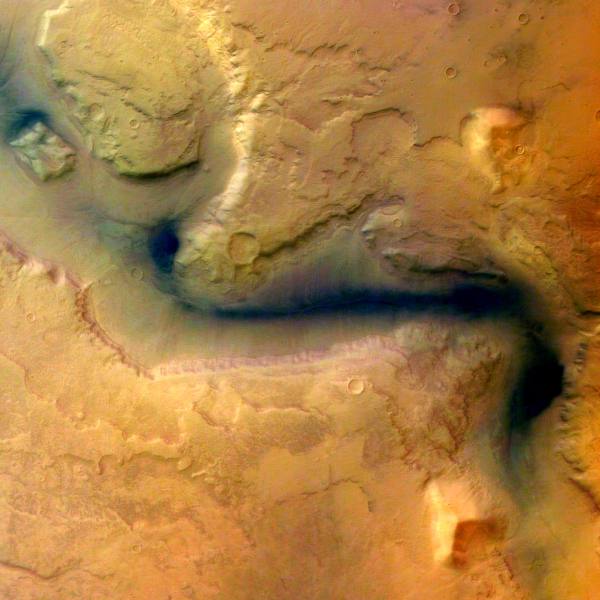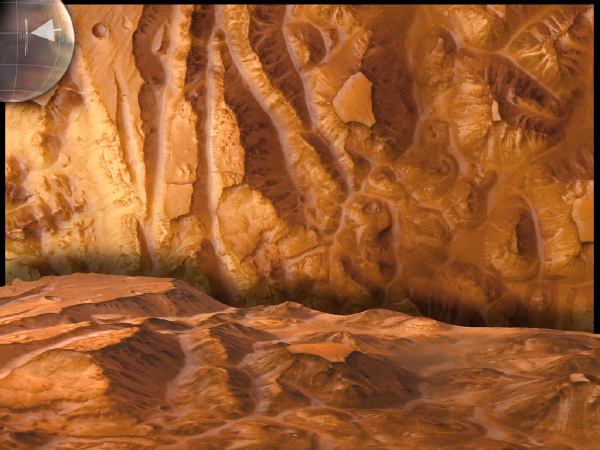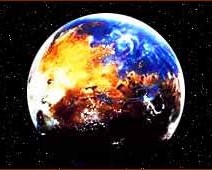 |
| What We Know About the Red Planet | ||||
| History | Water | Ice | Air | Canals |
| Seasons | Mountains | Rocks | SandDunes | Rift Valley |
| Moons | Dust Storms | Stats | Closest | Kid Pix |
| Lunar | Movies | Life Search | Wanted | Exploring Mars |
Little green men need water, too:
Was There Ever Water on Mars?
RECENT DEVELOPMENTS: MARS EXPLORATION ROVERS MARS CLOSEST TO EARTH IN 59,619 YEARS
Water once flowed on Mars...
NASA had a pair of robot explorers on the surface of Mars in 2004 searching for water. The exploration rover Spirit landed January 4 at Gusev Crater, which may be an ancient lake. Its twin, Opportunity, landed January 25 at Meridiani Planum, which has minerals associated with water. On March 2, NASA announced the rovers had confirmed liquid water once flowed on Mars.
Long ago and far away. When Italian astronomers a century ago peered though their telescopes at the planet's surface, they saw lines on the ground which they called channels. Unfortunately, when their Italian word was translated into English, the lines came out as canals. Well, everybody knows canals are artificial waterways built by intelligent beings, so, as a result, science fiction authors found a new source of scary tales about little green men.
Europe's Mars Express orbiter looked down on the ice cap covering the planet's South Pole. The photo at left is water ice. The middle image is carbon dioxide ice. The picture at right is visible light.
click image to enlarge - ESA
Mars Express recorded a 62-mile-wide swath of the Reull Vallis east of the Hellas basin from 170 miles overhead. The valley may have been carved in the ground by flowing water.
click image to enlarge - ESA
Mars Express snapped a spectacular stereo color picture from 170 miles above the surface of a 1,000 mile long by 40 mile wide swath of Valles Marineris, the so-called Grand Canyon of Mars.
click image to enlarge - ESA
Nobody said they were canals. Actually, the famous canals on Mars are an example of confusion about the red Planet. They were first observed by Italian priest Pietro Secchi in 1876. Then Giovanni Schiaparelli published a map of Mars in 1877. He assigned names to bright and dark features which included a large number of straight-line features that Schiaparelli and Secchi called "canali." The mistranslation in English-speaking countries of "canali" into "canal," instead of the correct "channel," brought a misleading connotation of artificial construction by Martians that had not been intended by Schiaparelli and Secchi.
The popular notion that Martian canals had been constructed by an heroic, intelligent race tapping melting polar ice for water to irrigate equatorial crops was argued persuasively by the famous astronomer Percival Lowell in his 1895 book. Not everyone agreed with the canal theory, but the idea of Mars supporting life became established and persists today.
Water Vapor. As far back as 1940, astronomers using telescopes with spectrographic measuring equipment knew oxygen and water vapor were extremely rare around Mars. The exact composition of the atmosphere only became known when interplanetary space probes from Earth began to examine the planet at close range.
The early Mars probe spacecraft found small traces of water vapor, but no evidence of life or canals on the Martian surface. However, the planet's south polar cap in early Spring showed frost-covered crater rims poking up through thick deposits of frozen carbon dioxide.
The Water Channels of Mars In the year 2000, NASA displayed new photographs that suggested there may be present-day sources of liquid water on Mars.
NASA MARS GLOBAL SURVEYOR IMAGES »
The space agency's scientists, looking at data from the Global Surveyor spacecraft orbiting Mars, observed features that suggest there may be current sources of liquid water at or near the surface of the Red Planet, according to a NASA announcement on June 22, 2000.Liquid water would have profound implications for the question of life on Mars, in the past and today. If life ever did develop there, and if it survives to the present time, it might be near the newly-discovered landforms.
- The new pictures reveal small features the size of a large car -- the smallest ever observed from Martian orbit. The newly-discovered features are comparable to marks left by flash floods on Earth.
- Relative to the rest of the Martian surface, the gullies seem to be extremely young. They could be a few million years old, but researchers don't rule out the possibility that some of them could have been formed in recent centuries.
Oceans probably were salty. Astronomers agree that Mars must have been warm and wet billions of years ago and that its oceans have long since dried up. Now, geologists say they have found evidence that those ancient Martian oceans were salty, just like the oceans on Earth today.
Geologists at Arizona State University and Los Alamos National Laboratory say their evidence is in chunks of rock that were knocked off Mars and fell to Earth as meteorites. They analyzed the inside of the 1.2 billion-year-old Nakhla meteorite, which fell on Egypt in 1911. During their anaylsis, they extracted salts (water-soluble ions) that more than likely were deposited their by brine (salt water) as it evaporated. The salts they found are like salts found in Earth's oceans.
The findings suggest a uniformity between the planets Earth and Mars. Scientists suggest that Mars may have supported life -- at least simple lifeforms like bacteria.
Water channels seen previously. Hundreds of long, winding channels on Mars look like dried-up rivers. In fact, they look like stream beds cut by sudden runoff in desert regions on the Earth.
Astronomers see the channels as evidence of liquid water erosion. Lava and glacial erosion would have produced very different channels. If so, the channels also are evidence that the climate on Mars has changed dramatically.
Of course, liquid water cannot exist on Mars today. If any buried water reached the surface, the planet's low atmospheric pressure would boil it to a vapor. Once in the atmosphere, the water vapor would circle the poles and freeze out.
Water channels suggest a time in Mars history when the atmosphere was much thicker. That would mean the climate once was warmer and wetter.
Counting craters in the dry river channels suggest they are several hundred million years old.
There is evidence the water which carved the channels is locked in polar ice caps buried under the two large carbon dioxide frost caps. That water, plus some frozen in the Martian soil, might be enough to form an ocean in the low-lying northern hemisphere. It might be several miles deep if melted.
The polar regions show evidence of Martian climate change. Under the ice, the terrain is layered. That can be seen where erosion has cut steep valleys and exposed sloping ridges. Layers of bright and dark material appear to be as little as 165 feet (50 meters) thick. The pattern suggests varying amounts of dust and ice were deposited over long time spans. The periodic variation may have been a response to slow changes in the polar climate.
MARS EXPLORATION ROVERS 2004 PATHFINDER WATER FINDINGS 1997 A RIVER RAN THROUGH IT MARS EXPLORATION ROVERS MARS CLOSEST TO EARTH IN 59,619 YEARS
Learn more: Human Exploration of Mars:
There have been three stages of exploration so farFlybys:
Probes fly by Mars taking pictures Orbiters:
Spacecraft fly into orbit above MarsLanders and Rovers:
- Orbiters
- Mariner 8-9
- Viking 1-2
- Mars Observer
- Mars Climate Orbiter
- Mars Global Surveyor
- Mars Global Surveyor home
- 2001 Mars Odyssey
- 2001 Mars Odyssey home
- Mars Express
- Mars Express home
- Mars Reconnaissance Orbiter 2005
- Mars Reconnaissance Orbiter home
Landers and rovers drop to the surfaceSand dunes: Dust Storms: Air: Carbon Dioxide: Outflow Channels: Valley Networks: Rift Valley: Ice: Ice caps: Frost: Water: Artesian Water: Mars Weather: Mars Photo Galleries: Planet features: Canals: Rocks: Mountains: Dating and aging: Seasons:



